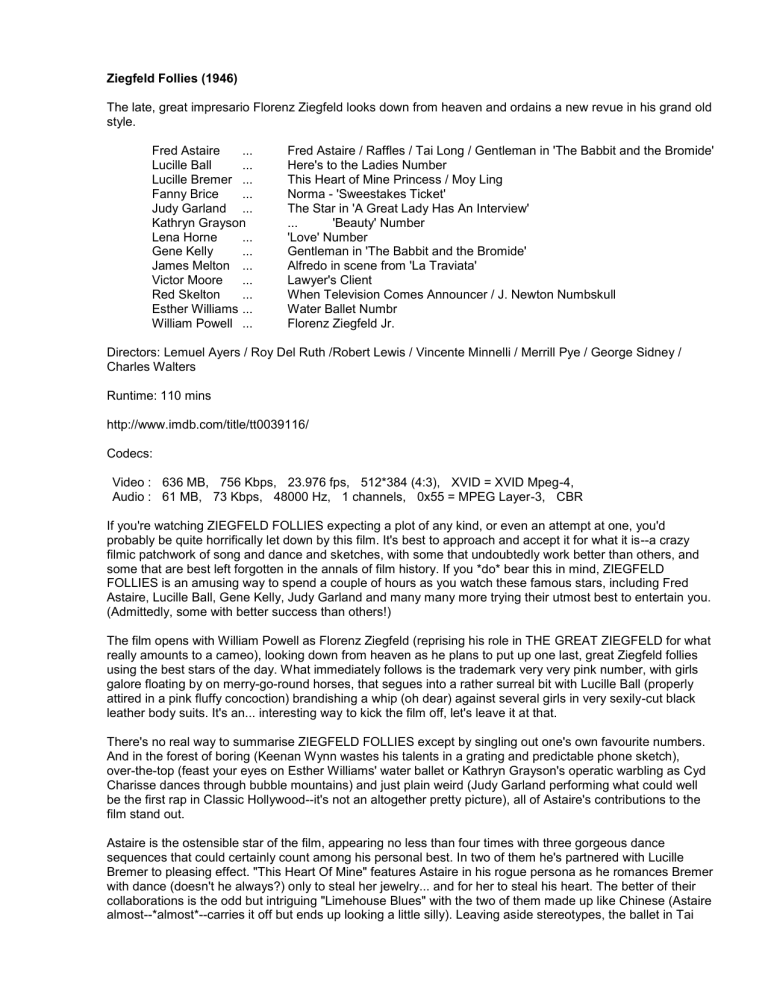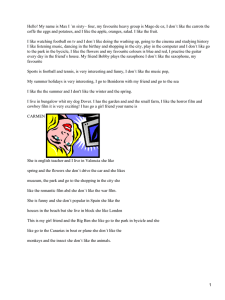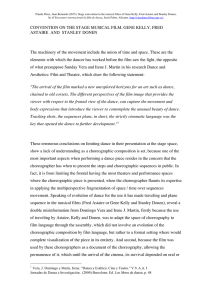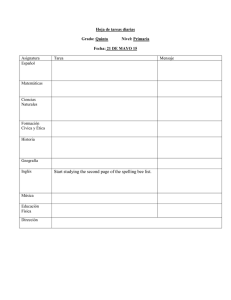Ziegfeld Follies (1946) Movie Review: Astaire, Kelly, Garland
Anuncio

Ziegfeld Follies (1946) The late, great impresario Florenz Ziegfeld looks down from heaven and ordains a new revue in his grand old style. Fred Astaire ... Lucille Ball ... Lucille Bremer ... Fanny Brice ... Judy Garland ... Kathryn Grayson Lena Horne ... Gene Kelly ... James Melton ... Victor Moore ... Red Skelton ... Esther Williams ... William Powell ... Fred Astaire / Raffles / Tai Long / Gentleman in 'The Babbit and the Bromide' Here's to the Ladies Number This Heart of Mine Princess / Moy Ling Norma - 'Sweestakes Ticket' The Star in 'A Great Lady Has An Interview' ... 'Beauty' Number 'Love' Number Gentleman in 'The Babbit and the Bromide' Alfredo in scene from 'La Traviata' Lawyer's Client When Television Comes Announcer / J. Newton Numbskull Water Ballet Numbr Florenz Ziegfeld Jr. Directors: Lemuel Ayers / Roy Del Ruth /Robert Lewis / Vincente Minnelli / Merrill Pye / George Sidney / Charles Walters Runtime: 110 mins http://www.imdb.com/title/tt0039116/ Codecs: Video : 636 MB, 756 Kbps, 23.976 fps, 512*384 (4:3), XVID = XVID Mpeg-4, Audio : 61 MB, 73 Kbps, 48000 Hz, 1 channels, 0x55 = MPEG Layer-3, CBR If you're watching ZIEGFELD FOLLIES expecting a plot of any kind, or even an attempt at one, you'd probably be quite horrifically let down by this film. It's best to approach and accept it for what it is--a crazy filmic patchwork of song and dance and sketches, with some that undoubtedly work better than others, and some that are best left forgotten in the annals of film history. If you *do* bear this in mind, ZIEGFELD FOLLIES is an amusing way to spend a couple of hours as you watch these famous stars, including Fred Astaire, Lucille Ball, Gene Kelly, Judy Garland and many many more trying their utmost best to entertain you. (Admittedly, some with better success than others!) The film opens with William Powell as Florenz Ziegfeld (reprising his role in THE GREAT ZIEGFELD for what really amounts to a cameo), looking down from heaven as he plans to put up one last, great Ziegfeld follies using the best stars of the day. What immediately follows is the trademark very very pink number, with girls galore floating by on merry-go-round horses, that segues into a rather surreal bit with Lucille Ball (properly attired in a pink fluffy concoction) brandishing a whip (oh dear) against several girls in very sexily-cut black leather body suits. It's an... interesting way to kick the film off, let's leave it at that. There's no real way to summarise ZIEGFELD FOLLIES except by singling out one's own favourite numbers. And in the forest of boring (Keenan Wynn wastes his talents in a grating and predictable phone sketch), over-the-top (feast your eyes on Esther Williams' water ballet or Kathryn Grayson's operatic warbling as Cyd Charisse dances through bubble mountains) and just plain weird (Judy Garland performing what could well be the first rap in Classic Hollywood--it's not an altogether pretty picture), all of Astaire's contributions to the film stand out. Astaire is the ostensible star of the film, appearing no less than four times with three gorgeous dance sequences that could certainly count among his personal best. In two of them he's partnered with Lucille Bremer to pleasing effect. "This Heart Of Mine" features Astaire in his rogue persona as he romances Bremer with dance (doesn't he always?) only to steal her jewelry... and for her to steal his heart. The better of their collaborations is the odd but intriguing "Limehouse Blues" with the two of them made up like Chinese (Astaire almost--*almost*--carries it off but ends up looking a little silly). Leaving aside stereotypes, the ballet in Tai Long's fevered dreams is quite stunning, and impeccably staged. I'm still trying to figure out how Astaire and Bremer managed to remember the exact way in which to flip their fans... I hate to think how many times they must have reshot that just to get it all perfectly synchronised! My favourite number in ZIEGFELD FOLLIES, small surprise, is the one I was looking out for: the penultimate number, "The Babbitt & The Bromide", featuring Astaire and Kelly together on screen, performing the same routine for once in their long illustrious careers. It's a funny little number, with the two fellows they play meeting each other at every stage of their lives, only to have the same inane, mundane conversation. Then follows a small bout of onemanupship as they try to out-dance the other, right into the gates of Heaven. Watching them together is a real treat, because you know these are probably the two best dancer/singer/actors ever committed to film. It's a bit of a shame that their styles don't quite gel: Astaire floats his way through the routine as Kelly pounds the ground as only he can, so their dancing is polished, in perfect time (the timing is absolutely amazing!), but just a little bit off-kilter. It's still the best number in ZIEGFELD FOLLIES though, with Kelly's irrepressible mischief playing against Astaire's ruffled charm. ZIEGFELD FOLLIES is really just a big, sparkly candy box of a movie--if you bear in mind that a plot was never particularly high on the mind of writers, producers, or directors, and you have a good book by your side to tide you through the (fortunately not too numerous) stretches of boredom, you're set for the evening. Keep the video ready for whenever Astaire breaks onto the screen; that's always a sign of quality. 7/10 .............................................................................................................................. The Ziegfeld Follies were legendary stage shows that consisted entirely of musical numbers and comedy routines performed by some of the greatest stars of the day. When sound began to roar in the late 1920s, the movie studios followed the Ziegfeld form and quickly produced a series of films that were variety-show in nature. But the musical review is a form that really works best on stage before a live audience: in short order the movie-going public turned its back on the style in favor of musicals that offered increasingly complex, sophisticated, and sometimes unexpectedly dark stories. In the 1940s MGM, famous for its musicals, unexpectedly decided to revive the form--and to do so in the style of producer Florenz Ziegfeld. The result was an outrageous budget that would have made Ziegfeld himself blanch, a wave of imaginative visuals that could have never been crammed onto even the biggest Broadway stage, a host of legendary performers, and the occasional comedy routine for relief from the sheer spectacle of it all. The big hurdle for modern audiences is the fact that we have become accustomed to variety shows through television; they no longer have a unique appeal and it is difficult for us to sit through two hours of it. Even so, most musical fans will probably find ZIEGFELD FOLLIES worth the effort; although it has a few weak spots, it is easily one of the most visually stunning flights of fancy ever put on the screen. The weakest links in the chain are the comedy routines, all of which seem insubstantial at best, slightly clunky at worst; still, they are amusing in an old-fashioned sort of way and it is always a pleasure to see the legendary Fannie Brice, no matter how inconsequential the script may be. Fortunately, the film weighs in heavily on the musical side, and while the actual material may be a bit weak at times the look of the thing is absolutely eye-popping. The opening number is nothing short of stunning: Fred Astaire introduces a riot in pink and black that includes a spinning Cyd Charisse, a turning merry-go-round with real white horses, and a formidable Lucille Ball keeping a host of leopard-like women in check with a whip! Truly, musicals are the most surreal of all performing arts genres, but this seems to stretch the boundaries quite a bit. The film is filled with notable performers. Virginia O'Brien, the great comic singer, dismisses the ladies in favor of the men--indeed, it seems, almost any man will do. Esther Williams swirls elegantly in front of lavish underwater sets. James Melton and Marion Bell offer memorable performances of the most famous duet from LA TRAVIATA in a memorably designed setting. Katherine Grayson is surrounded by some truly unexpected sets, walls of bubbles, and gold-clad bathing beauties. Certainly no one can complain that there is nothing to see on the screen! Along the way we also have some truly legendary moments, chief among them two amazingly beautiful dance numbers performed by Fred Astaire and Lucille Bremer. The first, "This Heart of Mine," finds Astaire playing a jewel thief bent upon seducing Bremer at a ball: red and white with elaborate costumes, hidden treadmills, and decoratively turning platforms, it is both clever and very elegant. Even so, "Limehouse Blues" is finer still, introducing a mysterious Chinatown--and then suddenly bursting into a fantasia of white and blue and red as Astaire and Bremer dance out a love story that never was and never could ever be. The film also offers two of MGM's most celebrated singing stars. During her MGM career Lena Horne was typically saddled with excessive movement and frequently peculiar costumes--but both actually work to her advantage here, and her performance of "Love" has tremendous tropical sizzle, to say the least. It may be a bit more difficult for modern viewers to know how to react to Judy Garland's "The Interview," for its references are lost; not only is it very much an industry insider joke, it is very much a take-off on "serious" actresses of the time who specialized in playing biographical roles, with Greer Garson a very specific target. Still, Garland nails it as only Garland can, and that says a great deal indeed. The film also contains a true rarity: the only serious pairing of Fred Astaire and Gene Kelly, who lightly send up rumors of their rivalry--and then proceed to demonstrate just how truly competitive they could be in some of the finest choreography ever put on the screen. "The Babbit and the Bromide" is truly a remarkable thing to behold; you are constantly torn in your attention between the two men, each with very different styles and yet each truly incomparable. In spite of its array of stars and remarkable visuals, ZIEGFELD FOLLIES was not among MGM's box-office knockouts of the 1940s and it was rarely seen after its original theatrical release. It is presently available only in VHS, and although the print is good it isn't the best possible--and since the visual spectacle is a prime reason for seeing the show you may want to hold out (and cross your fingers) for a full restoration on DVD. On the other hand, the out-of-print but still available VHS package does include the soundtrack on CD, which is a very strong plus. Final thought on the film: unless you are a serious fan of MGM musicals you may want to skip this one, but if you are willing to make the act of acceptance the film requires you'll find ZIEGFELD FOLLIES a drop-dead gorgeous show. .............................................................................................................................. When I first heard about this movie, & saw that the real Fanny Brice, Red Skelton, Judy Garland, & all the other greats from this era were in this, I knew I had to see it. I only wish the whole film lived up to the sum of its parts. The star power in this movie would blow anything over. I think the fault here is that the film comes off as a lot of dis-jointed performances which while well-staged & good, have nothing to tie you to the film & stay interested in it. The great musicals such as 2006's DreamGirls have that kind of thing. As a result, the main interest for someone watching this is to take a DVD of it with a scene menu & go to you favorite performers part in it. After seeing Streisand play Fanny Brice, it is interesting to see the real woman as she was versus Bab's portrayal of her. This film is lavish & MGM's Technicolor is great as usual. The film just doesn't flow very well which is a shame. It looks like no one wanted to hire good writers for a script. MGM made this on the presumption that just the stars would put people in the theater seats. I bet it did in it's time, but I only wish it had been done better now. .............................................................................................................................. * Original director George Sidney quit after one month of filming and was replaced by Vincente Minnelli. * Cut from the film: -- Musical number: "If Swing Goes, I Go Too" (music and lyrics by Fred Astaire), directed by George Sidney, sung and danced by Fred Astaire, audio available on Rhino's soundtrack CD and Warner Home Video's DVD. -- Musical/comedy number: "Start Off Each Day with a Song" (music and lyrics by Jimmy Durante), directed by Charles Walters, performed by Jimmy Durante. -- Musical number: "A Cowboy's Life," directed by Merrill Pye, sung by James Melton. -- Musical number: "Liza" (music by George Gershwin, lyrics by Ira Gershwin), directed by Vincente Minnelli, sung by Avon Long and the MGM Studio Chorus to Lena Horne, audio available on Rhino's soundtrack CD. -- Comedy sketch: "Baby Snooks and the Burglar," directed by Roy Del Ruth, performed by Fanny Brice, Hanley Stafford and B.S. Pully. -- Comedy sketch: "Death and Taxes," directed by Vincente Minnelli, performed by Jimmy Durante and Edward Arnold. -- Musical number: "We Will Meet Again in Honolulu" (music by Nacio Herb Brown, lyrics by Arthur Freed), directed by Merrill Pye, sung by James Melton, audio available on Rhino's CD and Warner Home Video's DVD. The Esther Williams water ballet from this sequence was reset to an instrumental version of "This Heart of Mine" (music by Harry Warren, lyrics by Arthur Freed). -- Musical number: "There's Beauty Everywhere" (music by Harry Warren, lyrics by Arthur Freed), directed by Vincente Minnelli, sung by James Melton and the MGM Studio Chorus, danced by Fred Astaire, Lucille Bremer and Cyd Charisse, Melton's audio available on Rhino's soundtrack CD and Warner Home Video's DVD. A segment with Miss Charisse and the "bubble girls" was retained in the revamped finale, which now featured Kathryn Grayson and the MGM Studio Chorus performing the vocal, Grayson's audio available on Rhino's soundtrack CD, and the revised scene available on Warner Home Video's DVD. * More than a year before the film's Manhattan opening, Decca Records issued a disc of Fred Astaire singing and tapping to a spirited song which he had written for the picture, a number which wound up on the cutting-room floor -- "If Swing Goes, I Go Too." On the flip side of the Decca 78, Mr. Astaire sang the romantic ballad which showcased him and Lucille Bremer in the movie, "This Heart of Mine" (music by Harry Warren, lyrics by Arthur Freed). The two Decca sides by Fred have been brought back on a French CD box set entitled "Songs & Pictures 1928-1944," released by EPM Music. * The initial version shown to preview audiences at the Fox Westwood Village Theatre in Los Angeles on November 1, 1944, was almost three hours long. * A year prior to the film's premiere in Manhattan, Decca Records released a Judy Garland 78 containing two songs from the score not performed by her in the movie: "Love" (music and lyrics by Hugh Martin and Ralph Blane), a fervent air which Judy sang on radio and then memorably, in 1963, on her TV series with Lena Horne; and "This Heart of Mine" (music by Harry Warren and Arthur Freed). Judy's two commercial discs, along with an alternate take of "This Heart of Mine," are presented on her CD box set from MCA, "The Complete Decca Masters (Plus)." * Judy Garland's number, "A Great Lady Has an Interview" (music and lyrics by Roger Edens and Kay Thompson, choreography by Charles Walters), originally was offered to Greer Garson as spoof of her high-toned Mrs. Miniver/Madame Curie image. When the songwriters demonstrated this change-of-pace routine at the home of Greer and her then-husband Richard Ney, the couple felt less than flattered and jointly rejected the proposal. * Although Kathryn Grayson would replaced James Melton in the finale, Victor Records issued, more than a year before the film's Manhattan debut, a commercial disc of Mr. Melton singing the closing number, "There's Beauty Everywhere" (music by Harry Warren, lyrics by Arthur Freed). * The horse ridden by Lucille Ball is the Lone Ranger's Silver. * One of only two films in which Gene Kelly and Fred Astaire danced together. The other was That's Entertainment, Part II (1976). * "The Babbitt and the Bromide" was a sketch taken from the original score of the Broadway musical "Funny Face" and intended for Fred Astaire and Adele Astaire. * The idea for the film had been in discussion at MGM since 1939. * Filmed in 1944, with retakes plus additional segments done in 1945, the movie was not issued nationally until April 8, 1946. * At the beginning of the "Bring On The Beautiful Girls" number several older women are shown. These were women who had actually appeared in the original Ziegfeld Follies on stage. * Fanny Brice's material in this picture had originated on stage and radio. "The Sweepstakes Ticket" was a Brice highlight during the Broadway run of "The Ziegfeld Follies of 1936." The second movie sketch, "Baby Snooks and the Burglar" (footage deleted and the now lost), already had been performed on radio by Fanny as the precocious Snooks, with Hanley Stafford as her exasperated Daddy. The "Sweepstakes" routine marks Fanny's last film appearance. * Among the ideas planned in the film, but not used, included: -- A spoof of the musical "Lady in the Dark" with Judy Garland, Mickey Rooney and Fred Astaire. -- A minstrel number with Garland, Rooney, Astaire, Lou Holtz and Nancy Walker. -- An "Album of Familiar Songs" medley with Garland, Marilyn Maxwell, Eddie 'Rochester' Anderson, Lena Horne, and Kathryn Grayson. -- A "Firehouse Chat," a sketch with Garland, Lucille Ball and Ann Sothern. -- "Reading of the Play," a sketch with Garland and Frank Morgan. -- "It's Getting Hot in Tahiti" (music and lyrics by Hugh Martin and Ralph Blane) with Garland. -- A "Fairy Tale" sketch with Katharine Hepburn, Margaret O'Brien and Jackie 'Butch' Jenkins. -- "I've Got Those Rooney/Pidgeon/Skelton Blues" with Garland, Ball and Greer Garson (in a number they'd concocted on a war bond train) moaning about their frequent co-stars. -- "Pass That Peace Pipe" (music and lyrics by Martin, Blane and Roger Edens) with Garland, Rooney, Ball, Walker, June Allyson, Gene Kelly and Charles Walters (The song was later given to Joan McCracken by Walters when he directed Good News (1947).) -- "Sand," a sketch with Garland and Astaire in blackface. -- "Children's Park" with various MGM stars (including Hepburn, Garland, Walter Pidgeon, Basil Rathbone, Tom Drake and Esther Williams) riding on swings. -- "I Love You More In Technicolor Than I Do In Black and White" (music and lyrics by Martin and Blane) with Garland turning down dates from John Hodiak, Van Johnson and James Craig to rekindle with Rooney. (This routine had to be dropped when Rooney entered the Army.) -- James Melton suggested he should do a number with either Garland or Grayson. * MGM gave this film a roadshow preview in Boston, Massachusetts, opening on August 20, 1945. Disappointed by the largely negative audience reaction, studio executives decided against quickly releasing the movie nationwide.




![No se lo digas a nadie [Don`t Tell Anyone], (Peru, Francisco](http://s2.studylib.es/store/data/005872151_1-1dd0893b8e1dbcf7a90c9884036118b5-300x300.png)
